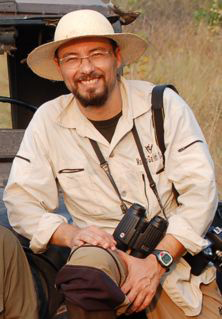Mauro Galetti solved Darwin's puzzle of the 'bright seeds'. This is what he told us about becoming an ecologist:
Like every kid, I always liked to be in the woods and watch animals in the zoo. When I decided to start my career in biology in Brazil, I did not really know what kind of job I would take, but I knew that to be successful in any career I needed to do what I enjoyed most. While at university I started studying the behavior of howler monkeys in a forest near my university. Twice a week I spent the whole morning studying what they ate, where they moved, how they divided the space with other animals. This gave me experience and time to watch other organisms in the forest, such as squirrels, birds, capuchin monkeys and, of course, plants. As a zoologist, I never realized how complex and interesting the strategies are that plants have evolved to attract animals for pollination or seed dispersal. I started collecting all kind of fruits in this wood and described for each species the strategy that they used for dispersal. Some fruits are dispersed by wind, a few by ants, but most of them (in Brazil) are dispersed by birds or mammals. My second favorite place was always the library of my university. After coming from the field, I spent one or two hours reading the scientific journals and books. Knowing what the "top scientists" are studying and why they are doing their research is a fundamental step for every student. Since most of the journals or books were in English, it took me a long time to translate each paper, or each book. This is certainly the largest barrier to doing science in non-English-speaking countries. Now, describing fruit strategies is a kind of hobby and job, and I enjoy traveling to new places to compare how plants disperse their fruits. This is relevant to understanding evolution and ecology, and has been a major tool in speeding up the restoration of wild places.
In one of these places I came across an Ormosia tree, full of red and black seeds, with no pulp. I knew from old naturalists, like Darwin, Ridley and van der Pijl, that some fruits 'tried' to mislead birds and evolved colourful fruits but no fleshy reward, the so-called mimetic seeds. I never took this idea for granted, and decided to investigate on my own. So, I spent two years coming every month to this place to study this species. First, I marked and mapped all Ormosia trees. I could find no more than eight trees in a 2200 hectare region! They were very rare. In the meantime, I also found several other species with the same strategy: Margaritaria nobilis, Rhynchosia pyramidalis and Abrus precatorius. After marking all the Ormosia, I started watching every morning, to see whether any bird would come to eat its mimetic fruits. After many, many days, no success. In the same place I found some fruiting trees of Copaifera langsdorffii, a leguminous tree, with a very similar fruit display, but with a pulp reward for the dispersers. So, I started my experiments transplanting Copaifera arils to Ormosia seeds and placed them on the ground to see whether wild birds would take them. Later, I decided to try with captive birds. My findings show that it is hard to mislead a bird, but naïve (captive-born) birds are easily misled by Ormosia seeds. Nowadays, I continue studying the adaptations of fruits to dispersal, especially the ones dispersed by extinct megafauna.




